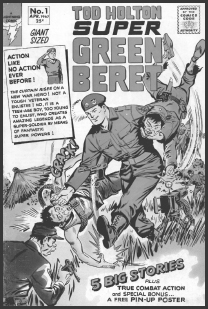1 Iron Man in Tales of Suspense (1963). Throughout the 1960s, several prominent superheroes signed up for tours of duty in Indochina, but only one originated in Vietnam. In 1963’s Tales of Suspense #39, millionaire industrialist Tony Stark is injured by a booby-trap in the jungles of Vietnam while demonstrating his high-tech “transistor-powered” weapons to the U.S. military. He is then captured by Wong-Chu, the “red guerrilla tyrant” of Vietnam, who orders Stark to build weapons for the commie cause. Instead, Stark builds a suit of armor he uses to blast the commie bastard back to the Stone Age. And thus, Iron Man is born.
2 Blazing Combat (1966). The first truly memorable portrayal of the Vietnam War in comics came courtesy of Warren’s short-lived Blazing Combat magazine. Most of its stories were written by the late, great Archie Goodwin and drawn by such luminaries as Gene Colan, Russ Heath, Alex Toth, and John Severin. Unfortunately, some of the book’s imagery (most notably a scene where Vietnamese peasants are burned to death) proved too inflammatory for audiences in 1966, and the series lasted just four issues. These days, the original issues of Blazing Combat command high prices.
3 Sgt. Fury and His Howling Commandos King Special #3 (1967). In its bid to become “the most talked-about work of war-mag wonderment ever published,” this fifty-page travesty features a cameo by President Lyndon Johnson (who speaks like a bad version of a Mark Twain character), Viet Cong fighters who look like Mexican banditos (and, like most other comic book VC of the era, speak fluent English, their favorite phrases usually being “Die, American swine!” and “Death to all Yankee imperialists!”), and a ridiculous plot to sabotage North Vietnam’s creation of a hydrogen bomb. Nick Fury’s well-formulated plan consists of the Howlers disguising themselves as Vietnamese refugees (a ploy that’s perpetrated merely by donning different hats), infiltrating the city of Haiphong, and detonating the bomb. “There she blows!” the Howlers joke as their plane soars above the mushroom cloud. Stan Lee presents…Nick Fury executing thousands of civilians! Excelsior!
4 Super Green Beret (1967). Tod Holton, all-American teenager, is given a magic, glowing beret by his uncle. Whenever he dons the beret…Shazam! Young Tod is transformed into an adult supersoldier, much like Captain Marvel in fatigues. As Super Green Beret, Tod is able to use his magic powers to aid the American troops in Vietnam by making “magic monkeys” appear to throw coconuts at the Viet Cong or by turning hand grenades into pineapples. Published by Lightning Comics, Super Green Beret only lasted for two issues in the spring of 1967. So unfortunately for all the GIs in Vietnam, Super Greenie Beanie was nowhere to be found come Tet 1968. Probably could’ve used some of those magic monkeys in Saigon or Hue City.
5 Vietnam Journal (1987). Vietnam Journal #1 was unleashed upon an unsuspecting populace in November 1987, courtesy of little-known Apple Comics. Borrowing a phrase from Full Metal Jacket screenwriter Gustav Hasford, Don Lomax’s vision of Vietnam had come to “mangle frail civilian sensibilities.” Comicwise, I’ve still never seen anything so horrific as the horribly burned chopper pilot from Vietnam Journal #7, whose leg comes off in a medic’s hands; the meticulously pockmarked landscape and the bullet-riddled bodies of Viet Cong in issue #4; the tangled mass of soldiers clinging desperately to a chopper’s rope ladder in #5; the poor grunt who’s been shot in the face on the opening page of #6; the bayoneted baby in #13; or the last three issues, #14–16, which are, without a doubt, the most brutal and disturbing comics I’ve ever read. Even today, Vietnam Journal is one of the most gritty and brutally honest war stories ever published.
One of the most popular writers at Marvel Comics, Jason Aaron is the current writer of Wolverine, The Incredible Hulk, Wolverine and the X-Men, and The Punisher. He also writes the critically acclaimed series Scalped for DC Comics’ Vertigo line of comics, about an FBI agent sent back undercover in the reservation where he grew up.
